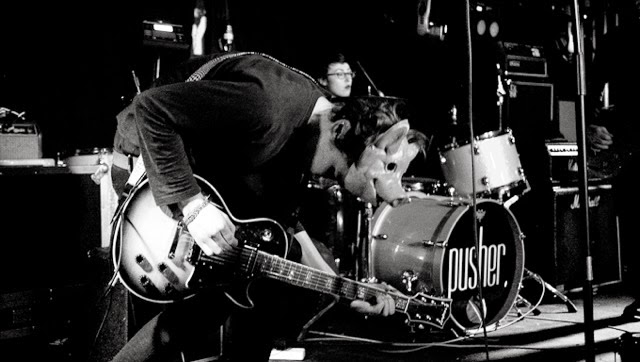Lo-fi noise avant guard é a praia dos ingleses do Sebastian Melmoth, é só pegar o cassete recém lancado In Ruins e sentir a que vieram os caras.
Experimentalismo dita a regra, ecos de pos punk leia-se PIL, são nitidos também, um pezinho no Slint e as referências são infinitas o fato é que os caras causaram um impacto aqui nestas páginas, vide a demora a este que vos escrever digerir o k7.
O Sebastian Melmoth desafia você a adentrar ao mundo dissonante de seus experimentalismos, e eu endosso
Q. When did Sebastian Melmoth start, tell us about the history...
Andreas Baader: Sebastian Melmoth began in earnest in 2010. Up until that point we had played a couple of gigs here and there, but never took it too seriously. The group had an anti-folk vibe in the vein of The Mouldy Peaches. It was mostly an acoustic affair and consisted of myself and Mandi Taylor, my partner at the time. We met Jan-Carl Raspe via a Gumtree advert and it soon grew into this strange post-punk thing with a drum machine, loops and a lot of fuzz. Ulrike Meinhof joined us on drums in early 2013, a few months prior to Mandi's departure. We've been quite prolific in our four year history, releasing four albums, an EP of remixes and a 7” single on our own Feline Vomitus imprint. In March 2014, a regressive Swedish label called Beläten, put out our latest effort, In Ruins. This album is a lot more introspective that what we had done previously, with an overarching electronic groove to match.
Q: Who are your influences?
Jan-Carl Raspe: The Who were a fine band, but I wouldn't say an influence... so the answer is no.
AB: We have eclectic taste and are generally influenced by a lot of different sounds and surprises. Most recently these have been: Liars; Deerhunter/Atlas Sound; Sonic Youth; Portishead/Beak; Spacemen 3; Leonard Cohen; Nico and Charles Mingus, among many, many others. However, I primarily see Sebastian Melmoth as a conceptual art piece. Therefore, there are a lot of other influences which come into play outside of the traditional popular music spectrum. John Cage's theory on sound and silence is particularly influential, as well as the writings of Albert Camus and Jean-Paul Sartre. The DADA and FLUXUS art movements played a big role in our creative development as well as our approach to disseminating content.
Q. Make a list of 5 albums of all time…
AB: On these we differ, so we've given you a list of ten, he he. Mine are...
Portishead – Dummy
Liars – they threw us all in a trench and stuck a monument on top
Radiohead – Kid A
Mogwai – Come On Die Young
Pixies – Doolittle
JCR:
Primal Scream - Screamadelica
Pink Floyd - Piper at the Gates of Dawn
PiL - Metal Box
John Lennon/Plastic Ono Band - John Lennon/Plastic Ono Band
Eno - Here Come the Warm Jets
Q. How do you feel playing live?
AB: Somewhere between catharsis, elation and sheer terror. Despite occasionally choking audience members, I still find it difficult to make eye contact.
JCR: I feel at times lost in the wall of sound, sometimes wondering what will happen next and most of the time feeling each gig is better than the last.
Q. How would you describe Sebastian Melmoth's sounds?
AB: A sad, little boy is wandering alone in a forest. His face is muddy and his shirt is torn. Leaves filter the sunlight. The air is thin and cold. After stumbling through dense, dark foliage for a distant age, the boy comes across a severed limb. Tears well up in the child's face. His cry is heard only by the murder of escaping crows.
JCR: There are no limits to the sound we create or will create. Everything is distinctive. Dark subjects, sometimes sung with a gleeful air.
Q: Tell us about the process of recording the songs?
JCR: Up to now it's been mostly songs written by Andreas. We discuss the sound and try to naturally piece together a song based around that discussion. Sometimes we start with nothing and build it up until a song formulates.
AB: Whereas previously we'd come into the studio with preordained songs and arrangements, we now tend to start with a unifying concept and build from there. Much like one builds a house. One brick at a time… and a lot of mortar - for lubrication. I tend to think of the recording process as a mildly sexual collaborative collage. Growing. Pulsating. Anti-climatic.
Q. Which new bands do you recommend?
dressmaker
Milky Onions
Johnny Halifax and the Howling Truth
The New Fabian Society
Gum Takes Tooth
Hebronix
Q: Which bands would you love to make a cover version?
AB: We've already recorded covers of Jethro Tull's My God, The Knife's Got to Let You, as well as Be a Caveman and 1969 by The Avengers and The Stooges respectively. We've also been talking about going for a drone version of Leonard Cohen's Avalanche. And personally, I'd like to cover Denise and Company's Take Me As I Am. It's one of those rare girl garage nuggets from the late 1960s. Jan-Carl Raspe wants to cover everything by Kraftwerk. So we're going to be very busy, I suppose.
Q: What are the plans for future?
AB: There was talk about recording a four track garage/surf EP and putting it out on vinyl. However, I feel like there's a new concept stirring in my loins so there may be something bigger on the horizon. We'd also like to play a few festivals and tour the UK, but none of us drive, so we might have to organise some sort of sonic hike round the countryside.
Q: Any parting words?
AB: Got any Salmon? Wicked!
JCR: Kiss me Hardy.
*
*
*
Thanks guys
http://youtu.be/BfZji9AotII
http://youtu.be/DBg-q0hfJoc
http://sebastianmelmoth.co.uk/
http://sebastianmelmoth.bandcamp.com/



